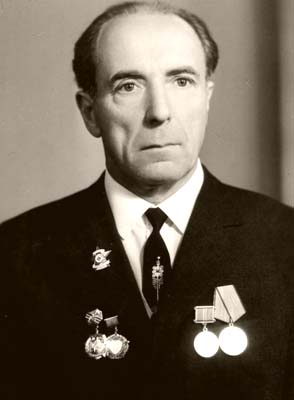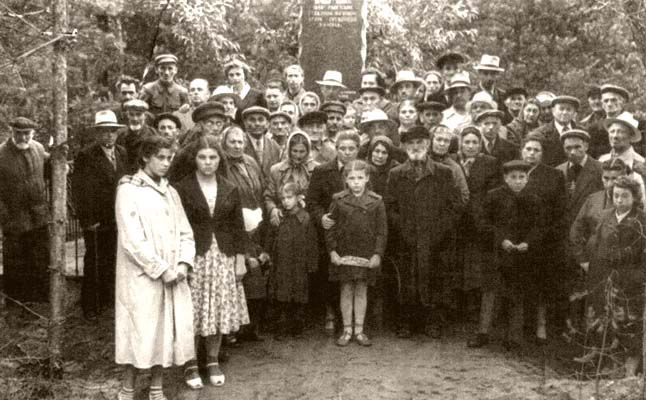

Project «Voices of Jewish settlements. Vitebsk region.»פיתוח קשרי התרבות בין העמים של ישראל ובלרוס
|
|---|
Website search |
|
MainNew publicationsContactsSite mapVitebsk regionMogilev regionMinsk regionMarina Voronkova
|
Yefim YudovinWITHOUT TIMEIt was in November, 1944. World War Two was still in progress. I was demobilized from the army after an injury and came back home to my native town of Beshenkovichi in Vitebsk region. Together with my parents we went to a settlement called Strelka, where I had lived before the war. I could not recognize the place. Most of the houses had been burnt down – the Germans had set them on fire before leaving. My parents’ house had been burnt to ashes. A woman we knew came up to us and offered to stay at her place. Her name was Yekaterina Bogdanovich. Her husband had been killed in the war and son Dmitry was handicapped as a result of a heavy injury. That was how the three of us ended up living in a small room. The inconvenience did not really bother us. What really concerned us was the fate of our relatives.  Yefim Yudovin
Yefim Yudovin
My grandmother Hiena, two mother’s brothers Elia and Faivl with their families, sister Haya-Etia with her son – the big Leitman family – used to live in one of the houses. My parents Meyer and Doba Yudovin, father’s brother Rafael-David with his wife and her mother, her sister Pesia with her husband Isaak used to live on the opposite bank of the river. My father told us that in 1922 there was a strong fire in Beshenkovichi, which destroyed the town center. Before 1917 this place used to be a typical Jewish shtetl, like many others in Belarus. Most Jews were craftsmen. There were mainly poor families with many children. Some Jews owned shops, located on the trade square and a few were quite well-off. Beshenkovichi used to have a few synagogues and heders, since most of the Jewish residents were religious and adhered to the traditional lifestyle: Sabbath and holidays. In the 1930s the Soviet authorities launched an anti-religious campaign and as a result the synagogues and heders were closed down. A local school, where all the teaching was done in Yiddish, was closed down in 1937. Nevertheless, the town still was Jewish. In June, 1941, we started the countdown of 1418 days and nights, of hard battles, colossal loss and suffering. Soon I, together with my mom’s two brothers Elia and Faivula, was mobilized to the army. Both of them went missing in the war. The rest of the relatives, not having any transport, did not manage to leave the town. They were sent to the local ghetto and later executed. The German troops appeared in Beshenkovichi on July 9th 1941. By that time a little over a thousand people had been left in the town. An acquaintance of mine, Sofia Petrovna Nemtsova, told me about the life of the local Jews in the ghetto. She did not evacuate at the beginning of the war. Therefore, when the Nazis invaded she found herself in the ghetto and had to experience all the hardships of the fascist rule. However she was lucky: she found out about the execution the day before it was going to take place and succeeded in escaping. Her acquaintance Nikolai Peregud helped her to escape and in the end she reached the partisans and was sent to a safe region. Nikolai Peregud was later instated “the Righteous among the nations”. Sofia Petrovna and her friends Pinia and Sosha Ruhman used to be my friends before the war. The parents had died a few years before the war started. After the war Sofia Petrovna worked in a kindergarten, however her health was damaged by the war stress and she died in 1961. This is what she told me: “As soon as the Nazis arrived they started gathering the locals into the ghetto. Those were somber days. Most of the Jews were forced out of their houses and made to live in the western part of the town, several families in each building. The Jews were prohibited to walk outside at night or leave the town. We were made to attach yellow Stars of David to our clothes. The life in the ghetto was like hell. It was getting increasingly difficult to exchange clothes for food. It was especially unbearable in winter – it looked like there was no hope for survival.” Yekaterina Bogdanovich, who gave us shelter, told us how they had lived under the German rule, as well as about the fate of the Jews and evil deeds of German lackeys from the local population. “The Germans came in the morning at about 10, approached our house and started asking where my husband was, whether there were any communists and Jews in our town, - she began her story. – And, naturally, a local person was “translating” for them. I said that my husband and son had been mobilized and that there were no communists in town. There were a few Jewish families. A few days later they prohibited us to talk to the Jews.” I asked her if she had seen my relatives. She replied: “I used to frequently see Itska – you aunt Pesia’s husband, and Rafael-David’s uncle, but I could not talk to them, because I was scared to.” She also narrated that at the beginning of winter, 1941, aunt Pesia’s neighbor –Vladimir Zhukovsky – forced their family to leave their house, together with her daughter and her four small children. Another neighbor sheltered them – it was incredibly cold outside. The following morning I went to the place of the execution – the edge of the forest next to the road. When I approached the place, I could not find the exact location of the grave. Suddenly I noticed two sections of land, which were covered with thick blackish crust, as if there had been a fire. I could not make out what it could be. Later I was told that before leaving the Nazis poured petrol onto the grave and set it on fire. My father’s neighbor, Nadezhda Harkevich, saw how the people had been taken to the execution site. Among them she recognized my relatives. “At about 10 in the morning I saw a big group of people on the river – they were being taken towards Strelki. As soon as they came up closer, I understood the people in the column were Jews – among them many children, old people and women. Men were few. The children were clinging to the parents and crying. They were accompanied by armed people in uniforms. I was so disturbed by the sight that I could not recover. Among the doomed I spotted your relatives: Musia – uncle Elia’s wife and her daughter Riva.” Another local resident, Stepan Zhukovsky, told me about the execution. “I came to the forest early in the morning and saw two big ditches. I realized they had been prepared as graves. About an hour later I noticed the first group of Jews approaching the graves. What a horrible sight! They were looking down and barely moved. Apparently they knew where they were being taken. I found a high tree not far away and climbed it. I could see everything that was happening. I saw all the details – the people taken to the ditches, undressed and shot. Children, weak people and old people were pushed into the grave alive and then shot. Local Nazi policemen were mostly the ones shooting, while the Germans were taking care of the victims’ clothes and choosing the jewelry they liked.” It happened on February 11th 1942. I will always remember this tragic date as most cruel and inhuman.  Opening of the memorial.
Opening of the memorial.
On the day of the execution my cousin Riva managed to hide herself in the basement of a neighboring house. However a former zoology teacher Konstantin Tserkovsky noticed that. He dragged her out and took her to the Nazi police. My father’s neighbor Stepan Gudian was also involved in reporting on a young woman who was hiding herself, and pushing her into the column of the victims, taken to the execution. Vladimir Zhukovsky served the Nazis all through the war and helped them to torture Jews. In our small town more than half of the men, that had not been mobilized, cooperated with the Nazis. All of them, except for Tserkovsky, were not punished for their crimes after the war. The wild merciless execution continued until late in the evening. One grave had 1068 people, 20 of them – my close relatives, among them 10 children and teenagers. Five families were exterminated completely. I sent the victims’ names to Yad Vashem. Every year we say a remembering prayer on February 11th. On the day of Shoah I take part in the mourning ceremony and remember everyone by the name. 12 years after the execution a memorial was erected on the execution site. There is an inscription: “1068 Soviet citizens, killed by Nazis, were buried here”. Lazar Mitzengendler, together with Berlin Peisah and Leib Pozharin, took part in memorial erection. The funds had been raised by the victims’ relatives. In 1954 about a hundred people came from different places in memory of their relatives that had perished there. One of the relatives took a picture of everyone who was there. I keep this precious photograph as a relic. I often take it out and think about my family. My relatives, killed by Nazis.
|
Hiena Leitman |
grandmother |
1868 |
Musia Leitman |
Uncle Elia’s wife |
1908 |
Riva Leitman |
cousin |
1923 |
Haim Leitman |
cousin |
1925 |
Pesia Leitman |
cousin |
1927 |
Sarah Leitman |
Uncle Faivul’s wife |
1910 |
Haim Leitman |
cousin |
1937 |
Haim Lihterman |
cousin |
1936 |
Haya-Etia Lihterman |
aunt |
1907 |
Leib Lihterman |
Aunt Haya-Etia’s husband |
1905 |
Rafael-David Yudovin |
uncle |
1882 |
Riva-Basia Yudovina |
Rafael-David’s wife |
1890 |
Riva-Basia’s mother |
|
1862 |
Pesia Yudovina |
aunt |
1884 |
Isaak Yudovin |
Aunt Pesia’s husband |
1882 |
Ida Ravvina |
cousin |
1906 |
Dvoira Ravvina |
Cousin’s daughter |
1927 |
Rachel Ravvina |
Cousin’s daughter |
1935 |
Sheina Ravvina |
Cousin’s daughter |
1939 |
Genia Ravvina |
Cousin’s daughter |
1940 |
Main |
New publications |
Contacts |
Site map |
Vitebsk region |
Mogilev region |
Minsk region |